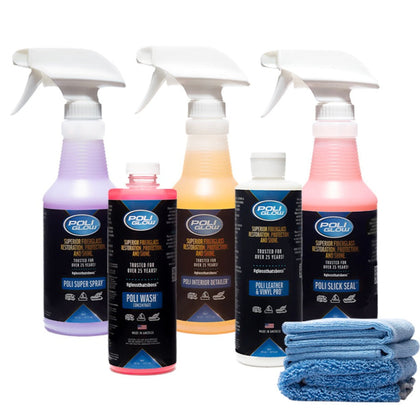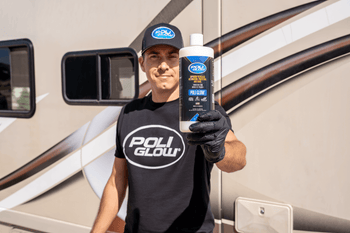
From Restoration to Protection: The Distinct Roles of Polishing and Waxing Boat Hulls
Time to read 16 min
Maintaining a boat's hull in pristine condition is an essential aspect of boat ownership that often goes overlooked, yet its importance cannot be overstated. The difference between a well-maintained hull and a neglected one can manifest in both aesthetics and performance. This blog post aims to elucidate the distinct roles of polishing and waxing in preserving and restoring boat hulls. Waxing provides a protective layer against environmental elements such as UV rays and saltwater, whereas polishing serves primarily to restore the hull's original luster and eliminate imperfections. Understanding these two processes in depth will equip boat owners with the necessary knowledge to extend the longevity and improve the performance of their vessels.
The Basics of Boat Maintenance

The importance of maintaining a boat's hull is often underscored by its direct impact on the vessel's performance, longevity, and resale value. A well-maintained hull ensures optimal hydrodynamics, allowing the boat to move efficiently through water, thus conserving fuel and ensuring smooth operation. Additionally, regular hull maintenance extends the boat's lifespan and can significantly contribute to maintaining its resale value, making it an economically sound practice.
Boat owners commonly encounter various problems when it comes to hull maintenance, each of which poses its own challenges and necessitates specific remedial actions. These issues can include:
- Oxidation and Fading: Prolonged exposure to direct sunlight can lead to oxidation, which dulls the hull's finish and leads to color fading.
- Saltwater Corrosion: Saltwater is particularly harsh on boat hulls, potentially causing corrosion if a protective coating is not applied and maintained.
- Scratches and Scuffs: Everyday use, docking, and encounters with debris can result in scratches and scuffs that, over time, may penetrate the gel coat, requiring more intensive restoration efforts.
- Algae and Barnacle Build-up: Marine growth like algae and barnacles can attach to the hull, affecting performance and fuel efficiency. These require regular cleaning to prevent permanent damage.
- Waterline Stains: These are discolorations that occur at the waterline and are typically caused by tannins, algae, or mineral deposits.
- Structural Issues: Neglected maintenance can lead to more severe problems like blistering or delamination, compromising the hull's structural integrity.
Understanding these common issues underscores the necessity for regular and comprehensive hull maintenance, which generally includes cleaning, polishing, and waxing. A consistent maintenance schedule can help mitigate these issues and create a more durable and efficient vessel.
What Is Polishing?
Polishing is a mechanical process that involves using abrasives to remove the outer layer of oxidation, tough stains, and minor imperfections from a boat's hull. The primary aim of this procedure is to restore the gel coat surface to its original luster and smoothness. Polishing enhances the boat's aesthetic appeal and prepares the surface for subsequent protective treatments such as waxing.
There are various types of polishing products and equipment available in the market, tailored to suit different types of boat hull materials and conditions:
- Liquid Polish: Often used for light to medium oxidation, liquid polish is suitable for both hand application and machine buffing.
- Paste Polish: Generally used for heavy oxidation and deeper scratches, paste polish offers a more concentrated abrasive component.
- Polishing Pads: These come in varying degrees of abrasiveness and are generally used in conjunction with a rotary or orbital buffer for more uniform results.
- Rotary Buffers: These high-speed machines effectively remove heavy oxidation but require experience to prevent surface damage.
- Orbital Buffers: Slower and less aggressive than rotary buffers, orbital buffers are easier to control and are better suited for light to medium oxidation removal.
- Microfiber and Foam Applicators: These are used for hand application of polish, suitable for smaller areas, or for boats with intricate detailing.
The frequency of polishing varies based on several factors, including the type of waters the boat frequents (saltwater vs. freshwater), the amount of sun exposure, and the type of hull material. As a general guideline, boats frequently exposed to harsh environmental conditions may require polishing as often as twice a year. In contrast, boats in more benign conditions may only require this treatment annually.
Understanding the appropriate polishing products, equipment, and frequency tailored to your boat's specific needs is crucial for effective hull maintenance. Properly executed polishing can significantly improve your vessel's aesthetic and functional aspects.
The Role of Polishing in Restoration
Polishing plays a pivotal role in the restoration process of a boat's hull, serving multiple functions that contribute to the overall condition and longevity of the vessel. The primary objective of polishing is to remove surface imperfections, ranging from light oxidation and minor stains to deeper scratches and scuffs. By eliminating these blemishes, polishing restores the original shine and color of the boat's hull, thereby rejuvenating its appearance.
- Removing Oxidation, Stains, and Minor Scratches: One of the foremost tasks is the removal of oxidation, a common issue that arises due to prolonged exposure to environmental elements like UV rays and saltwater. Oxidation manifests as a chalky, dull finish that detracts from the boat's aesthetics. Similarly, stains from tannins, mineral deposits, and other substances can mar the surface. Polishing eliminates these issues, thereby revitalizing the boat's exterior.
- Restoring the Original Luster of the Boat: Polishing employs fine abrasives to level the surface of the hull, which not only removes imperfections but also prepares the surface for the next stage of restoration—applying a protective layer of wax. By restoring the original luster, polishing returns the boat hull to a condition often comparable to a new or well-maintained boat. This process is not merely cosmetic; a well-polished surface offers less resistance when traveling through water, potentially resulting in improved fuel efficiency.
Post-polishing, boat owners can expect to see a noticeable difference in their vessels' appearance. The hull will exhibit a restored mirror finish, free from the dullness and discoloration caused by environmental wear and tear. Importantly, polishing also results in a smoother surface, which is beneficial for subsequent treatments like waxing, as it allows for more effective adhesion of the protective layer.
What Is Waxing?
Waxing is the application of a protective layer of wax to a boat's hull to shield it from environmental factors such as UV rays, saltwater, and physical abrasions. Unlike polishing, which focuses on restoring the existing surface, waxing aims to provide a barrier that maintains the condition of the hull over time. This protective layer not only enhances the boat's aesthetic appeal by adding a glossy finish but also prolongs the lifespan of the underlying material.
Various types of waxes are designed to cater to different needs and conditions faced by boat hulls. Some common types include:
- Carnauba Waxes: These waxes, derived from the carnauba palm leaves, are known for their high-gloss finish and water-repellent properties, but they may require more frequent reapplication.
- Synthetic Waxes: These are synthetic polymers designed for durability and longevity. They offer extended protection but may not provide as high a gloss as natural waxes.
- Cleaner Waxes: These are all-in-one products that combine mild abrasives with a protective wax layer, useful for minor touch-ups but generally not as effective as separate polishing and waxing processes.
- Specialty Marine Waxes: These waxes are specifically formulated for marine environments and often include additional UV inhibitors and anti-corrosive agents.
The frequency of wax application varies depending on several factors, such as the type of water the boat is used in (saltwater vs. freshwater), the amount of UV exposure, and the specific wax product used. Generally speaking, boats regularly exposed to harsh environmental conditions may benefit from waxing every three to six months. A semi-annual or annual waxing may suffice for boats in more moderate conditions.
Waxing serves as a preventive measure that complements the restorative effects of polishing. By understanding the different types of waxes and the appropriate application frequency, boat owners can significantly enhance the protective qualities of their hulls, thereby extending the lifespan and maintaining the value of their vessels.
The Role of Waxing in Protection
Waxing plays a crucial role in protecting a boat's hull, serving as the final line of defense against a myriad of environmental stresses that can degrade the vessel's appearance and integrity. While polishing aims to restore and correct existing imperfections, waxing focuses on preserving and protecting the newly restored surface from future damage.
- UV Protection: One of the primary benefits of waxing is its protection against UV damage. Prolonged exposure to UV radiation can result in oxidation and fading of the hull's paint or gel coat. A good wax creates a barrier that deflects UV rays, slowing the oxidation process and retaining the hull's color and gloss for extended periods.
- Water-Repellent Properties: Waxes typically have hydrophobic characteristics, making water bead up and roll off the surface rather than sticking to it. This feature is not merely aesthetic; it minimizes surface tension when the boat is in motion, potentially improving fuel efficiency.
- Anti-Corrosive Protection: The wax layer acts as an anti-corrosive barrier, especially pertinent to boats that navigate saltwater. Saltwater is a known catalyst for corrosion, particularly on metal fittings and fasteners on the hull. A protective layer of wax can mitigate these corrosive effects, prolonging the lifespan of these components.
- Resistance to Physical Abrasions: Everyday boating activities can expose the hull to physical abrasions from debris in the water, docking procedures, or contact with other boats. A well-applied layer of wax can protect against these minor physical impacts, reducing the likelihood of scratches and scuffs that compromise the hull's integrity.
- Enhancing and Maintaining Aesthetics: While the primary purpose of waxing is protection, the added benefit is aesthetic enhancement. A good wax will give the hull a glossy finish, amplifying the effects of prior polishing and providing a visually pleasing appearance that also contributes to the vessel’s resale value.
Waxing is an indispensable component of comprehensive boat hull maintenance. Its protective qualities guard against environmental and physical stresses, thereby preserving the boat's appearance and functionality. By understanding the protective benefits of waxing, boat owners can make informed decisions that contribute to their vessels' long-term care and performance.
The Steps to Polishing and Waxing

Executing the processes of polishing and waxing with meticulous attention to detail is essential for achieving optimal results. The following steps outline the sequence and best practices for each process, designed to guide boat owners through a thorough and effective maintenance routine.
Steps for Polishing:
- Preparation: Before starting, remove any loose dirt or debris from the hull using a soft brush and marine-friendly soap. Make sure the hull is completely dry before proceeding.
- Product Selection: Choose a polishing compound suitable for your boat’s material and condition. Marine-specific polishing compounds are generally recommended.
- Application: Apply the polishing compound to a small hull section using a clean, soft cloth or a rotary buffer. A machine buffer may be more effective for larger boats or severe oxidation.
- Buffing: Carefully buff the applied area using a circular motion. Pay attention to pressure and duration to ensure an even finish.
- Inspection: Wipe away any residual compound and inspect the finish. Repeat if necessary before moving on to the next section.
- Completion: Once the entire hull has been polished, perform a final inspection to ensure uniformity and identify any areas requiring a second pass.
Steps for Waxing:
- Preparation: Ensure the hull is free of dirt, debris, and any residual polishing compound. The entire surface must be clean and dry.
- Product Selection: Choose a wax suitable for marine environments and your specific needs (UV protection, saltwater resistance, etc.).
- Application: Using a clean, soft cloth or foam applicator, apply the wax in a thin, even layer over a small section of the hull.
- Buffing: Buff the wax using a soft cloth or a machine buffer, much like polishing. The goal is to achieve a high-gloss finish.
- Inspection: Examine the waxed area for any streaks or missed spots and reapply if necessary.
- Completion: Continue this process for the entire hull. Once finished, perform a comprehensive check to ensure that the wax layer is uniform and intact.
Here are some expert advice:
- Safety: Always wear appropriate safety gear such as gloves and eye protection, particularly when using machinery.
- Environmental Considerations: Always follow the manufacturer’s instructions and environmental guidelines when disposing of used materials.
- Timing: Plan to wax immediately after polishing to maximize the protective benefits and to seal in the polished surface.
By adhering to these steps and utilizing the appropriate products, boat owners can ensure that polishing and waxing are carried out to the highest standard. Not only does this comprehensive approach enhance the aesthetic appeal of the vessel, but it also contributes to the longevity and overall value of the boat.
When to Polish vs. When to Wax
Determining the appropriate time for polishing versus waxing is crucial for effective boat hull maintenance. Although both processes aim to improve and maintain the condition of the hull, they serve distinct roles and are performed under different circumstances.
Polishing is generally undertaken when the boat exhibits signs of surface degradation. These indicators may include:
- Oxidation and Fading: A chalky, dull finish is a clear sign that oxidation has occurred and polishing is needed.
- Stains and Discoloration: Visible waterline stains, rust, or tannin marks are other reasons to consider polishing.
- Scratches and Scuffs: Minor physical abrasions that haven't penetrated the gel coat or underlying material can often be remedied through polishing.
- Uneven Texture: A rough surface likely needs polishing to restore its smoothness.
- Preventive Maintenance: Even without visible signs of degradation, polishing may be performed periodically as preventive maintenance, especially before the application of a new protective wax layer.
Waxing, being a preventive measure, is generally undertaken under the following conditions:
- Post-Polishing: A freshly polished surface should always be waxed to seal the surface and maintain its restored condition.
- Change in Water Beading: When water no longer beads on the surface, it indicates that the previous wax layer has worn off and reapplication is necessary.
- Seasonal Change: Many boat owners opt to wax their vessels at the onset of boating season to provide maximum protection during periods of active use.
- Environmental Exposure: Boats subjected to harsh conditions such as intense sun or saltwater may require more frequent waxing for optimal protection.
The frequency of polishing and waxing a boat's hull varies based on factors such as environmental exposure and the material of the hull. Polishing is generally required less frequently, potentially ranging from twice a year to once every couple of years, depending on specific conditions. On the other hand, waxing should be performed more often, typically every three to six months, to maintain optimal protection. Waxing should be done immediately following a polishing procedure to seal the restorative effects and provide continuous protection for the boat's hull. Following these guidelines ensures the vessel's aesthetic appeal and functional integrity.
Factors to Consider in Hull Maintenance
Proper hull maintenance requires careful consideration of various factors that influence the necessity and effectiveness of polishing and waxing procedures. Awareness of these variables ensures boat owners can make informed decisions tailored to their specific needs and conditions.
- Material of the Hull: Fiberglass, aluminum, or wood materials have distinct maintenance requirements. For example, aluminum hulls may require specialized polishing compounds designed to prevent corrosion, while wooden hulls may benefit from varnish in addition to polishing and waxing.
- Environmental Exposure: The environmental conditions to which a boat is exposed play a significant role in determining maintenance frequency and product selection. Boats in saltwater environments may require more frequent care and specific types of wax to prevent corrosion, while those in freshwater or less intense sun may have different requirements.
- Usage Frequency: A regularly used boat will naturally require more frequent maintenance than one stored for long periods. Increased usage exposes the hull to elements that contribute to wear and tear, necessitating more regular upkeep.
- Current Condition: The existing state of the boat's hull will also dictate the type and extent of maintenance required. A hull with visible signs of oxidation or staining will benefit more from a thorough polishing session followed by waxing than a well-maintained hull that may only require a new coat of wax.
- Types of Products: Not all polishing and waxing products are created equal. The choice of product can considerably impact the effectiveness of maintenance. Marine-specific products often offer advantages such as UV protection, which is crucial for boats exposed to intense sunlight.
- Budget and Time Constraints: While using quality products and methods is essential, boat owners must also consider the practical aspects of time and cost. Higher-end products may offer longer-lasting protection but come at a higher price point. Time investment also varies depending on whether one opts for manual application or mechanical buffing.
- Regulatory Guidelines: Compliance with environmental regulations is imperative. Certain polishing compounds or waxes may contain restricted substances. Always ensure that the products used comply with local and federal guidelines to avoid penalties.
By considering these factors, boat owners can develop a targeted and effective hull maintenance strategy. This ensures not only the aesthetic appeal but also the functional integrity and longevity of the vessel.
The Benefits of Combining Both
Utilizing both polishing and waxing in a coordinated maintenance routine offers a holistic approach to boat hull care, amplifying the individual benefits of each process. This synergistic effect provides comprehensive protection and restoration, ensuring the vessel remains aesthetically pleasing and functionally sound.
- Enhanced Durability: When polishing is immediately followed by waxing, the hull gains a reinforced layer of protection. Polishing removes imperfections and prepares the surface for the wax, which then seals these restorative effects under a durable protective layer. This combination significantly extends the lifespan of the hull's surface material, be it fiberglass, aluminum, or wood.
- Improved Aesthetics: Polishing alone can yield a high-gloss finish, but adding boat wax to this process takes this to another level. The boat wax provides an extra layer of shine, enhancing the aesthetic quality of the boat. This is pleasing to the eye and can contribute to the vessel’s resale value.
- Comprehensive Protection: Each process offers unique protective qualities—polishing for surface restoration and waxing for environmental resistance. When used together, they deliver an all-encompassing shield against UV rays, saltwater corrosion, and physical abrasions. This level of protection is often greater than what each process could achieve individually.
- Increased Fuel Efficiency: A smooth, well-maintained hull offers less resistance when moving through water. Polishing levels the surface, removing imperfections that create drag, and the subsequent wax layer aids in water-repellency. These factors combine to allow for potentially greater fuel efficiency during operation.
- Maintenance Efficiency: Executing both processes in a single maintenance cycle is also efficient from a time and effort perspective. Polishing prepares the surface for the wax, meaning the latter is more effective and may last longer, thereby reducing the frequency of future maintenance procedures.
The combined application of polishing and waxing offers manifold benefits, optimizing everything from the boat’s appearance to its durability and performance. Integrating both processes is strongly advised for boat owners looking to achieve a comprehensive and effective maintenance regimen.
Tips for Choosing High-Quality Polishes and Waxes
Selecting the appropriate polishing and waxing products is crucial for achieving the best possible results in boat hull maintenance. High-quality products enhance your vessel's aesthetic appeal and significantly contribute to its longevity and performance. Below are several tips to guide you in choosing the most suitable products for your specific boat needs.
- Assess Your Boat's Hull Material: First, identify the material of your boat's hull. For instance, aluminum hulls may benefit from a polish designed specifically to inhibit corrosion, while wooden hulls may require a compatible varnish or sealant.
- Examine Environmental Factors: Consider the environmental conditions your boat is usually exposed to. If your boat is predominantly used in saltwater or prone to UV damage, look for products with added corrosion inhibitors and UV protection.
- Review Product Specifications: Always read product labels and specifications carefully. Look for key terms like "marine-grade," "UV protection," "anti-corrosion," or "biodegradable," as these often indicate a higher-quality product designed for specific marine conditions.
- Check User Reviews and Recommendations: While manufacturers provide extensive product details, actual user reviews can offer valuable insights into a product's effectiveness under real-world conditions. Peer recommendations can be a reliable guide, especially from boat owners with similar hull materials or environmental exposures.
- Consult Professionals: If in doubt, consult marine maintenance professionals for personalized advice. Their experience can provide nuanced recommendations that can save you both time and money in the long run.
- Opt for Reputable Brands: While lesser-known brands may offer competitive pricing, established brands usually have a track record of reliability and performance. Investing in proven products often results in a more effective and longer-lasting finish.
- Consider Application Method: Some products are formulated for hand application, while others are designed for machine buffing. Your choice may depend on the available tools and the time you can dedicate to the maintenance process.
- Conduct a Patch Test: Before applying any product to the entire hull, it’s advisable to perform a small patch test. This will help you determine if the product is compatible with your boat's material and if it provides the desired finish.
- Factor in Frequency of Use: More durable polishes and waxes may be cost-effective for boats that are used frequently, as they can reduce the overall frequency of maintenance sessions.
By carefully considering these factors, boat owners can make an informed decision in selecting the best polishing and waxing products tailored to their specific needs. In doing so, they contribute not only to the boat's visual appeal but also to its long-term durability and performance.
When it comes to restoring and protecting boats, one innovative option that boat owners should consider is Poli Glow®. Unlike traditional polishing and waxing methods, Poli Glow® offers a specialized system tailored for boats. It involves a unique process utilizing products like Poli Prep® , Poli Ox® , and Poli Glow® to rejuvenate the boat's surface and create a long-lasting smooth surface. This system is especially adept at combating oxidation and enhancing the appearance of older boat hulls. For boat owners seeking an efficient and durable solution, Poli Glow® is a noteworthy choice in boat detailing and maintenance.






